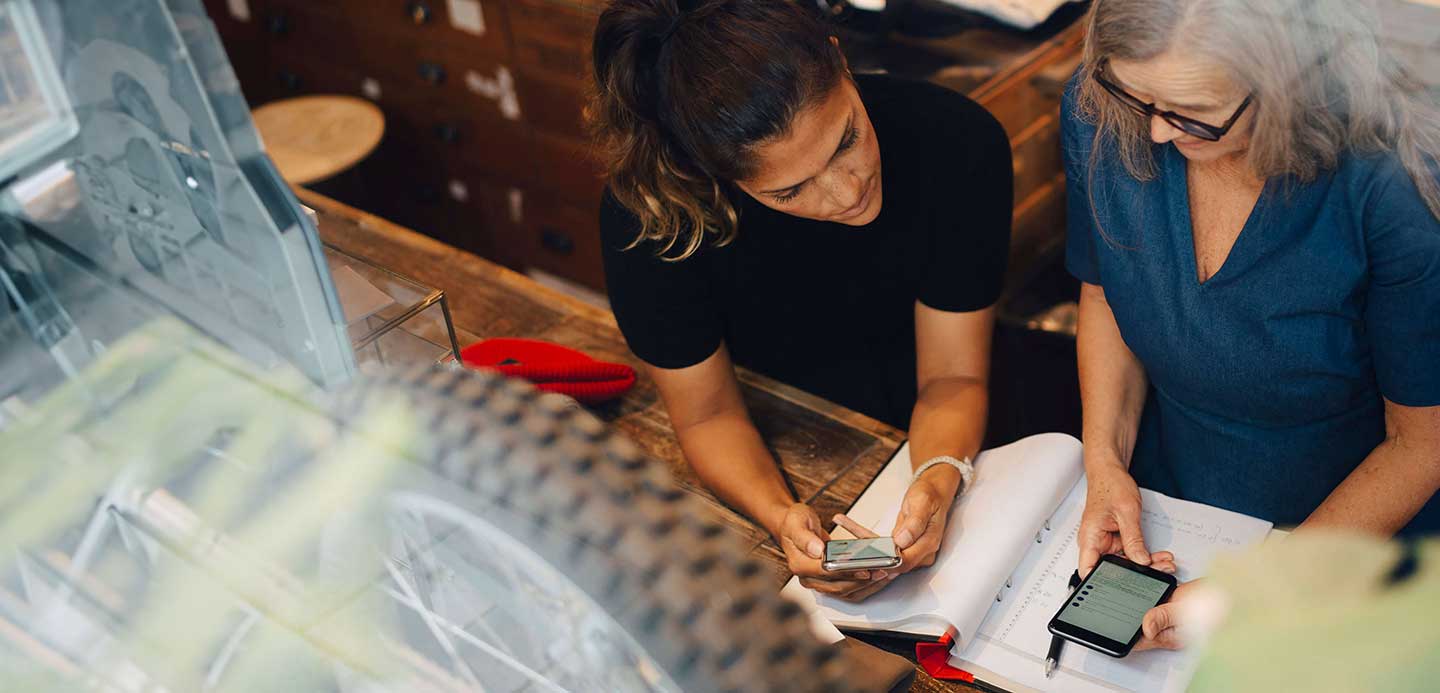- Article

- Starting a business
- Business planning
How to write an invoice
If you’re charging customers for services or products, you’ll need to get to grips with how to write an invoice. The invoice process should be as streamlined and efficient as possible – and we’re here to help you master the essentials.
What is an invoice?
How do invoices work?
When are invoices issued?
How to write an invoice
What to include on an invoice
How to structure an invoice
Invoice example
How to send an invoice
How long do invoices take to process?
Do I need to add VAT on my invoice?
What to do with overdue invoices
An invoice doesn’t have to be complicated, but there are fundamental items to include. These can apply whether you're a sole trader, a partnership, or a limited company, and whether you invoice regularly or from time to time.
This helpful guide sets out the basics you need to know when preparing an invoice template for your customers – whether it’s new to you, to help improve your record-keeping, or to make it easier to get paid.
What is an invoice?
An invoice is a formal document asking for payment from your customers for goods or services you have provided. It should detail what your customer needs to know about the payment, to be able to pay you by a due date.
If your business and your customer or client are both value added tax (VAT) registered, you must supply invoices by law. But even if you aren’t VAT registered, it’s good practice to provide, store and track invoices if you’re selling goods or services. It’s important for your own accounting and tax purposes, but it can also help establish a professional image for your business.
How do invoices work?
Once you write an invoice, issuing it is the first step in requesting payment from customers. At its most basic, an invoice sets out how much the customer owes you, what for, how to pay and a payment deadline. You can raise your invoices manually or through invoicing software, usually after you’ve provided the product or service.
If the customer has the information they need, they can make payment by the methods you’ve set out. If you have invoicing software, you can usually enable automated reminders for payment.
Once the invoice is settled, make sure you have a record in your ledger. It’s important to know that an invoice isn’t the same as a receipt, which is confirmation of payment made.
When are invoices issued?
It is up to you when you send out invoices, but it’s sensible to issue them as soon as you’ve provided the service or product. Being prompt will notify your customer that payment is due and put you on the road to getting paid and maintaining a healthy cashflow.
There are exceptions, though, depending on the type of work you’re supplying and what you’ve agreed.
For example, if you have a retainer for work with the client, you may prefer to send invoices on a regular basis (e.g. monthly), rather than straight after you’ve supplied them. Or, if the purchaser has agreed to an upfront payment, you would tend to invoice earlier on in the process.
How to write an invoice
The first step to writing an invoice is getting your template prepared. Your template for invoicing needs to include certain information and clearly explain payment terms. The following is a good place to start:
What to include on an invoice
You will want to include the following when you write an invoice:
- Invoice date: This can be different from the date when you did the work or supplied the goods.
- Invoice number: This unique number usually increases incrementally with each invoice you issue (for example, 10001, 10002, 10003).
- Purchase order number (if applicable): This is a reference code that helps with tracking that some customers need for payment authorisation.
- Your company details: This should include your business or individual name, email and postal address.
- The client / customer’s name and contact details: You may also want to include the name of a key contact you dealt with when you carried out the work or sold the goods.
- Date you supplied any goods and services: This can show the time gap between supplying the service or product and the invoice date.
- Description of what you are charging for: Include a full breakdown of items and costs, such as hourly rate or quantities supplied.
- Total amount due: This is the exact amount you are billing for. Also state whether this is inclusive or exclusive of VAT and, if VAT is chargeable, the rate and amount.
- Payment terms and details: Include the due date and how to pay (such as bank sort code and account number) and any late payment fees that might apply.
Bear in mind that there are differences to the information on a business invoice depending on whether you are a sole trader or limited company. For example, if you’re a limited company, include the full company name as it appears on your certificate of incorporation. If you’re a sole trader, include your name and any business name you have and an address for correspondence.
How to structure an invoice
You may want to use a free online template for an invoice, or one that’s provided with invoicing software packages. You can then adapt it for your own purposes, such as adding a logo or a line in the footer to say thanks for their business.
When it comes to the order of information from top to bottom, it tends to run as follows (where applicable):
- company logo
- company name and address
- company registration number
- date of supply
- customer’s name and address
- invoice number
- purchase order (PO) number
- date of invoice
- breakdown of costs
- total due
- payment details and terms
Whatever invoice format you choose, make sure the information is clear and that the customer will know it’s an invoice.
Assign the document a unique number, which can increase sequentially (for example, 10011, 10012, 10013). Keep a record of which stage each invoice has reached e.g. issued, pending payment, overdue or paid, and stay consistent with your name and numbering system.

Invoice example
We’ve created an invoice template for you to customise for your specific requirements.
How to send an invoice
You can send invoices by email or through invoicing software, though you can also send them by post if preferred by the customer.
The immediate benefit of using invoicing software is to make the process automated and efficient, incorporating built-in payment options, in a secure environment. Some invoicing software can also integrate with contract management software and your business bank account.
If your business is VAT registered, you must keep digital records of invoices that are compatible with HMRC’s Making Tax Digital software, so you can submit VAT returns digitally.
How long do invoices take to process?
The time it takes for your customer to recognise, approve, authorise, and pay the invoice will vary. Some customers will be more streamlined than others and adopt a more efficient processing workflow.
You can help the process by including all the information they need for payment and authorisation and by making sure all information on the invoice is accurate.
The standard timeframe for invoice payment is within 30 days of issuing it (unless you have agreed a different length of time). The time it takes the customer to process the invoice should fall within that.
Do I need to add VAT on my invoice?
You only need to add VAT to your invoices if your company and your customer are both VAT registered. Clearly set out the VAT you are charging and the rate, and the VAT-inclusive and VAT-exclusive price. Your company VAT registration number should be clear on your invoice.You must be VAT registered if your turnover is over a certain threshold in the last 12 months. You can register with a lower turnover if you think it will benefit your business, though. For example, you might want to be able to claim VAT back on your own business purchases.
What to do with overdue invoices
Unfortunately, not all customers pay on time. Keeping clear records and using automated software can help you keep on top of outstanding payments. If you have multiple clients, this is essential.
You have a right to charge customers interest on late payments, if you wish. You may want to include this in your original invoice, in the payment terms, but you can claim interest even if you haven’t stated it previously.
It’s important to communicate with your customer in the first instance. A polite and timely reminder by email or over the phone can sometimes be enough of a prompt and can also help maintain client relations.
If these measures aren’t leading to payment, it’s possible to make a statutory demand for payment of overdue invoices. This is a notice that you are prepared to take court action unless your debtor pays – or you both reach an agreement for payment – within 21 days.
Make sure you keep a record of every communication, including how you set out the payment terms.
Disclaimers
1. Free UK digital banking means day-to-day standard electronic transfers made through Business Internet Banking and HSBC UK Business Banking app are free. Other charges apply e.g. cheques and CHAPS. See Business Price List for details. Subject to application, eligibility, credit check and T&Cs.
2. Borrowing is subject to application, eligibility, affordability and credit check. T&Cs, fees, charges and rates apply. For loans, you don’t need to open or maintain an HSBC Business Current Account unless a debenture or fixed charge over book and other debts is required.





